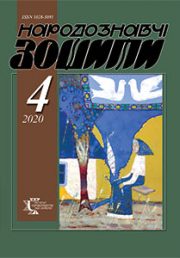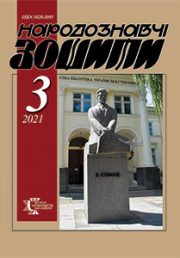The Ethnology Notebooks. 2025. № 3 (183), 716—728
UDK 746.3.071.1О.Сапеляк
DOI https://doi.org/10.15407/nz2025.03.716
ARTISTIC WORK OF OKSANA SAPELYAK
VYNOHRADSKA Halyna
- ORCID ID: https://orcid.org/0009-0008-3814-7661
- Leading curator of the «Folk Fabric» fund,
- Museum of Ethnography and Art Crafts of the Institute
- of the National Academy of Sciences of Ukraine,
- Secretary of the Ethnography Commission
- of the National School of Arts,
- 15 Svobody Avenue, 79000, Lviv, Ukraine,
- Contacts: e-mail: hanna.vynohradska0104@gmail.com
Abstract. The study of biographies and various spheres of activity of famous figures of Ukrainian science is always relevant, taking into consideration the broader and more complete disclosure of all facets of the formation of a creative personality. The artistic achievements in the field of embroidery of the famous Ukrainian scientist-ethnologist Oksana Sapelyak are for the first time taken as the object of a separate study. Before this, we have only a few brief references to this area of the scientist’s activity in the literature. Therefore, the purpose and subject of this article is to highlight and analyze the prerequisites, reasons, and process of formation of O. Sapelyak as a folk craftsman; to analyze and classify chronologically and typologically her embroidered products, their artistic features.
The article highlights the stages and events of O. Sapelyak’s life path, which are important in terms of her formation as an artist. The creative works of O. Sapelyak are considered, from the first children’s attempts in the 1950s to highly artistic embroidered products in the status of a people’s master in the 1980s. A diverse range of products is studied: 1) clothing (women’s and children’s shirts and blouses, suits); 2) consumable items (pillowcases, table napkin sets, festive Easter towels); 3) interior decorative items (subject paintings, towels, napkins, runners).
The creative approach of the craftswoman and her author’s style are analyzed, as they are based on folk samples from private and museum collections, have an author’s character, elements of novelty, and are characterized by ease in compositional solutions, a combination of execution techniques, and color.
The importance of Oksana Sapelyak’s reproduction and preservation for future generations of little-known works of art by O. Kulchytska and S. Shabatura is emphasized. The continuity of the artistic family tradition from grandmother to grandson through the mediation of her mother, a scientist and craftswoman, Oksana Sapelyak, is also traced.
Keywords: Oksana Sapelyak, Olena Kulchytska, Stefaniya Shabatura, dissidents, embroidery, shirt, towel.
Received 9.06.2025
REFERENCES
- Sapelyak-Denysovets, Oksana Adamivna. (2010). Biobibliographic index. Lviv [in Ukrainian].
- Vynogradska, G. (2010). «Speak to me, so that I may see you»: about some conferences with Oksana Sapelyak. Ethnology notebooks, 5—6, 514—517 [in Ukrainian].
- Vynogradska, G. (2015). In creative cooperation. Ethnology notebooks, 2, 349—352 [in Ukrainian].
- Vynogradska, G. (2020). Oksana Sapelyak. Bulletin of the National School of the Ukrainian SSR, 63, 99—100 [in Ukrainian].
- Nikorak, O. (2015). Her life credo. Ethnology notebooks, 2, 344—348 [in Ukrainian].
- Sapelyak, Oksana. (2001). What is most important. Lviv [in Ukrainian].
- Fedoriv, L. (2010). Red-black reminiscences of her life. In: Sapelyak-Denysovets Oksana Adamivna. Biobibliographic index (Pp. 28—34). Lviv [in Ukrainian].
- Interview with Oksana Sapelyak. February 17, 2025. Recorded by G. Vynogradska [in Ukrainian].
- Gel’, I. (2010). Public work of Oksana Sapelyak. In: Sapelyak-Denysovets Oksana Adamivna. Biobibliographic index (Pp. 9—16). Lviv [in Ukrainian].






